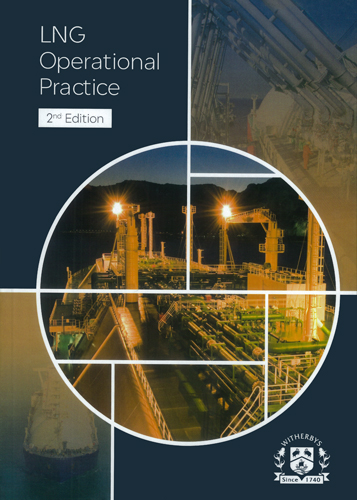LNG Operational practica
Мы не можем гарантировать его наличие и поступление на наш склад по указанной цене
Издание на английском языке.
All cargo related procedures vary depending on the type of LNG carrier. However, there are a large number of fundamental aspects to these procedures that are common throughout the trade. The following text discusses these generic aspects and processes in a logical sequence and provides a commentary and instructions based on established good practice. It should be noted that for each LNG carrier, all associated procedures are clearly defined and laid out in the form of a Cargo Operations Manual, which must be suitably referenced, be available to all and written in a style for ease of understanding. In general, the main points of this manual are set out in the form of a check-list to simplify the procedure for the operator. However, these checklists only list the necessary steps and are not an in-depth understanding of a process, which is mainly gained by learning and experience. This book is written for Officers in a key position or any other who requires a better understanding of the mechanics and processes. It provides checklists, narrative and instructions for each of the operations undertaken and, where appropriate, provides an insight into the underlying chemistry that determines them. Drawing on 25 years of experience in the trade, this book provides the level of instruction and description that would have been welcomed during the earlier days of my career on LNG Carriers. It will prove of real value to this next generation of LNG specialists.
Contents
Preface
Acknowledgements
Section 1: General Information
1 Physical Properties, Composition and Characteristics of LNG
1.1 Overview
1.2 Flammability of LNG
1.3 Saturated Vapour Pressure (SVP)
1.4 Vapour Density
1.5 Safety Precautions in LNG Handling
2 Normal Trading Cycle of an LNGC
3 Cargo Containment Systems
3.1 Overview
3.2 Moss Rosenberg (Moss)
3.2.1 Leak detection
3.3 Mark III (GTT)
3.3.1 Membrane or primary barrier
3.3.2 insulation and secondary barrier
3.3.3 Interbarrier and insulation space (IBS/IS) N2 pressurisation and control system
3.4 N096 (GTT)
3.4.1 Primary insulation space (PIS) and secondary insulation space (SIS) N2 pressurisation and control system
4 Cargo Handling Equipment
4.1 Cargo Pump
4.2 Spray/Stripping Pump
4.3 High Duty Compressor
4.4 Low Duty Compressor
4.5 Gas Heater
4.6 Vaporiser
4.7 Reliquefaction Plant
4.8 Gas Combustion Unit (GCU)
5 Auxiliary Equipment
5.1 The Cargo Valves Remote Control System
5.2 Ship/Shore Link and ESD System
5.3 N2 Generator
5.4 IG Plant
5.5 Custody Transfer and Measurement System (CTMS)
5.6 Cargo Tank Gauging System
5.6.1 Cargo tank float gauge
5.7 Gas Detection Equipment
5.8 Cofferdam Heating System
5.9 Vacuum Pumps
5.10 Tank Overflow Protection
Section 2: Post Dry-dock Operations
6 Operations Related to Auxiliary Systems
6.1 Moss Type LNG Carriers
6.1.1 Overview
6.1.2 Removing ambient humid air from the hold spaces
6.1.3 Drying and inerting of tank insulation and annular space
6.2 Membrane Type LNG Carriers (Mark III and N096)
6.2.1 Overview
6.2.2 Removing ambient humid air from the insulation spaces of Mark III cargo containment system
6.2.3 Removing ambient humid air from the insulation spaces of N096 cargo containment system
7 Cargo Tank Operations
7.1 Drying of Cargo Tanks
7.1.1 Overview
7.1.2 Preparation for drying
7.1.3 Operational description - cargo tanks drying
7.1.4 Further considerations
7.2 Inerting of Cargo Tanks
7.2.1 Overview
7.2.2 Preparation for inerting
7.2.3 Operational description - inerting cargo tanks prior to gassing-up
7.2.4 Further considerations
7.3 Gassing-up the Cargo Tanks
7.3.1 Overview
7.3.2 Preparation for gassing-up
7.3.3 Operational description - gassing-up the cargo tanks with LNG vapour and IG vented to atmosphere
7.3.4 Operational description - gassing-up the cargo tanks with LNG vapour and IG returned to shore
7.3.5 Further considerations
7.4 Initial Cooldown of Cargo Tanks
7.4.1 Moss type LNGC
7.4.2 Membrane type LNGC
7.4.3 Operational description - cargo tanks cooldown
7.4.4 Further considerations
Section 3: In-service Operations
8 Loading Operations
8.1 Overview
8.2 Preparation for Loading
8.3 Pre-loading Operations
8.4 Cooldown for Loading
8.5 Ramp-up to Bulk Rate
8.6 Bulk Rate Loading
8.7 Ramp-down
8.8 Post-loading Operations
8.9 Departure from Load Port
9 Laden Voyage
9.1 Overview
9.2 Laden Voyage of LNG Carriers with Gas Burning Propulsion System
9.2.1 Steam plant
9.2.2 Engines and generators
9.2.3 Consideration for all gas burning system
9.3 Laden Voyage of LNG Carriers with Reliquefication Plant
9.4 Further Considerations on Laden Voyage
10 Discharge Operations
10.1 Overview
10.2 Preparation for Discharge
10.3 Pre-discharge Operations
10.3.1 Operational description - MLAs and liquid header cooldown prior to discharging
10.4 Ramp-up to Bulk Rate
10.4.1 4-step ramp-up
10.4.2 8-step ramp-up
10.5 Operational Description - Bulk Rate Discharge
10.6 Ramp-down
10.6.1 Ramp-down 'heel retained'
10.6.2 Operational description - ramp-down 'heel out' (cargo tank stripping)
10.7 Post-discharge Operations
10.8 Departure from Discharge Port
10.9 Further Considerations During Discharge
11 Ballast Voyage
11.1 Overview
11.2 Heel Management
11.2.1 Heel management of LNGCs with a gas burning propulsion system
11.2.2 Heel management of LNGCs with a reliquefaction plant
11.3 Further Considerations on Ballast Voyage
12 Ship to Ship Transfer Operations
12.1 Pre-arrival Stage
12.2 Approach and Mooring Stage
12.3 Cargo Transfer Stage
12.4 Post-transfer Procedure
Section 4: Pre Dry-dock Preparations
13 Cargo Tank Operations
13.1 Warming-up Cargo Tanks
13.1.1 Overview
13.1.2 Preparation for warming-up
13.1.3 Operational description - cargo tanks warming-up
13.1.4 Further considerations
13.2 Inerting of Cargo Tanks
13.2.1 Overview
13.2.2 Preparation for inerting
13.2.3 Operational description - cargo tank inerting after warming-up
13.2.4 Further considerations
13.3 Aeration of Cargo Tanks
13.3.1 Overview
13.3.2 Preparation for aeration
13.3.3 Operational description - cargo tank aeration
13.3.4 Further considerations
Glossary




